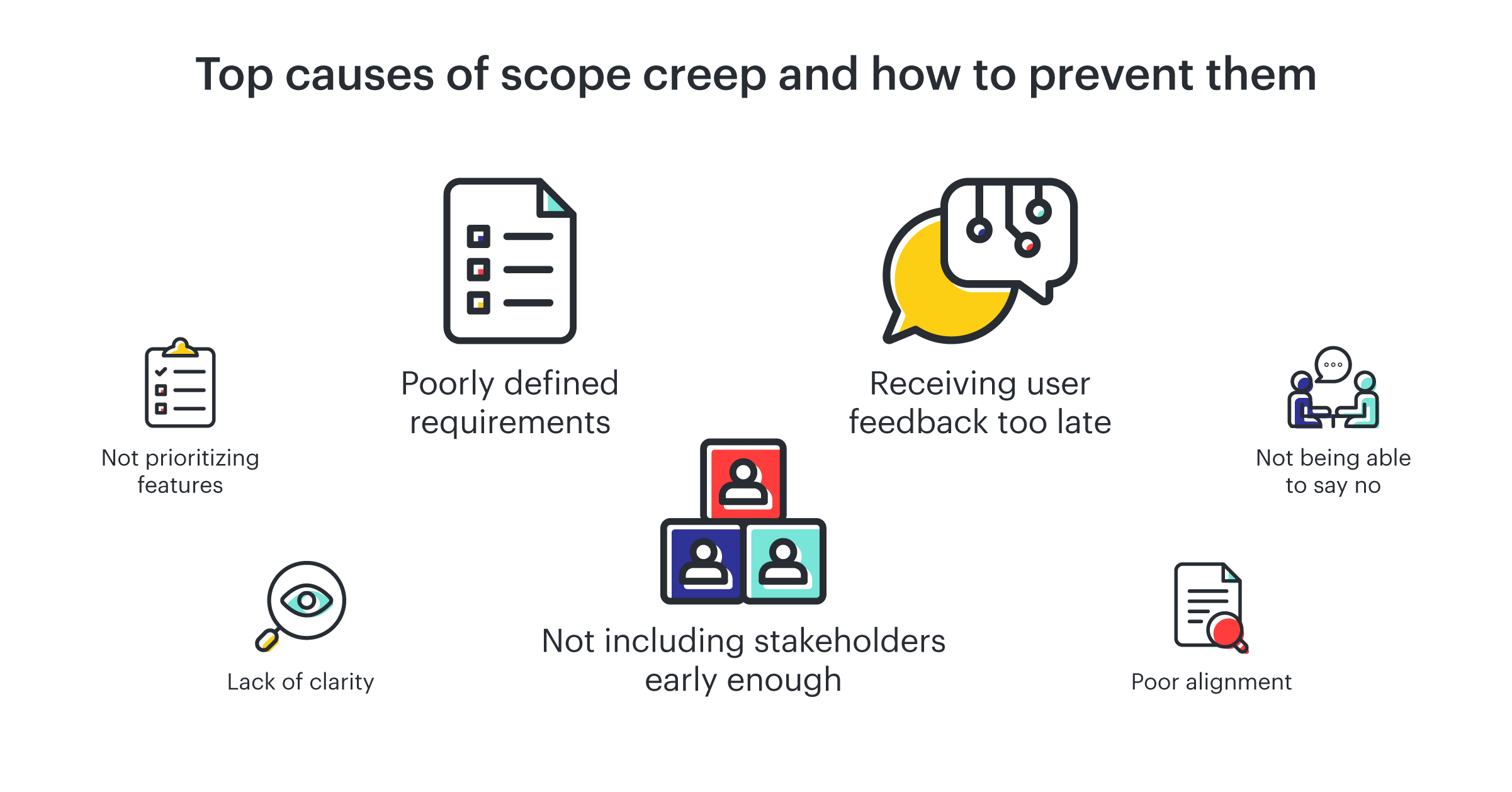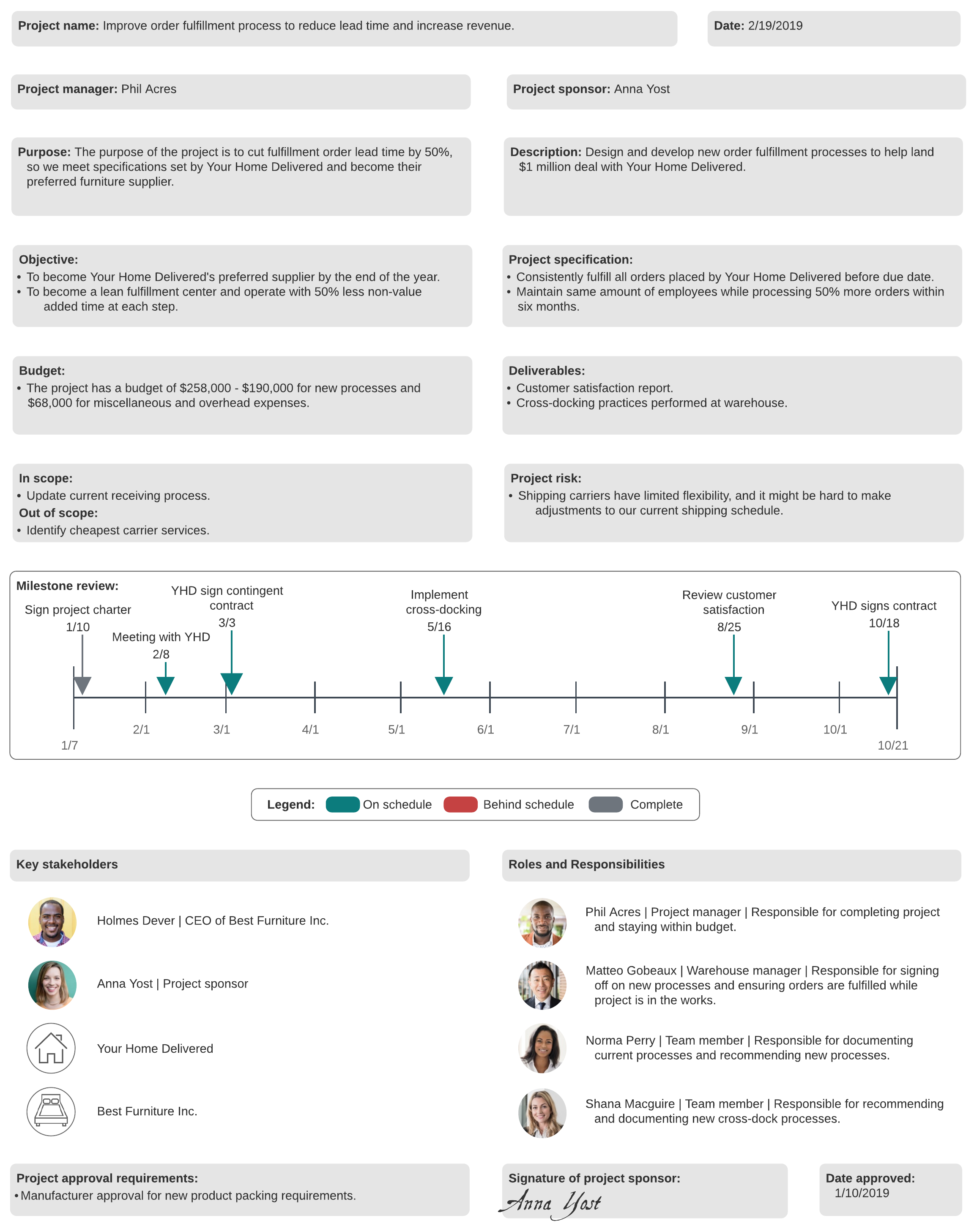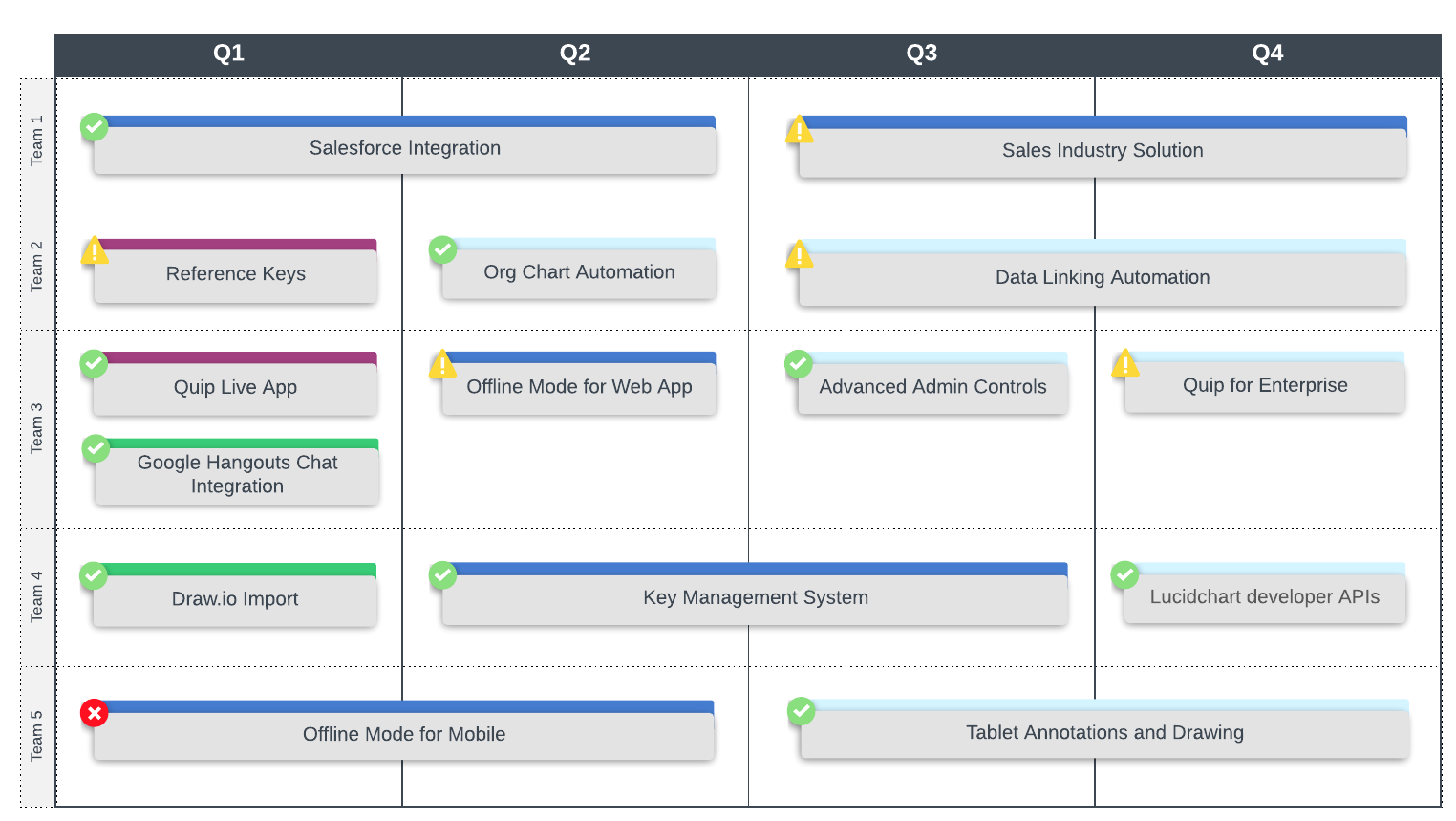
How to avoid scope creep (and the circumstances that lead to it)
Lucid Content
Reading time: about 8 min
Topics:
Every development team in every company has had to deal with a project that seems to take on a life of its own. Requirements, demands, and other work are added to the project without moving the release date.
There is usually a little wiggle room to work in some things that were not part of the original project scope. But too many of these unplanned additions can cause real problems with your timelines, budgets, productivity, and quality control.
In this article, we will discuss ways to prevent too many unexpected additions or changes from creeping into your projects.

What is project scope?
The scope in project management is the part of your plan that lists project goals, deliverables, tasks, costs, budgets, deadlines, timelines, and resources you will need to complete the project.
Your project scope is used to document the project’s boundaries, list team member responsibilities, and define the processes that will be used to test, verify, and approve completed work.
What is scope creep?
Scope creep is a term used to describe what happens when your project starts to grow beyond its original goals and boundaries. This can happen when the team doesn’t understand the project’s scope or when unplanned “must-have” features are added. It can also happen when a stakeholder requires additional features or functions without regard to the time constraints or budget.
It’s very rare that a project ever goes from inception to completion without changes being made along the way. You can usually make small adjustments that will keep you on track. But if there are too many change requests—if you need to throw more resources, money, and time at the project—that’s when scope creep can cause you some real problems.
How can you build flexibility into your scope?
Because you know that there will likely be some scope creep, you might want to plan for a little flexibility when you define the scope to address minor changes. That doesn’t mean that you should plan for changes to the scope, schedule, and budget. Instead, you need to determine which boundary in your project is flexible.
To do this, use the triple constraint theory (also called the project management triangle), which states that when one boundary is flexible, the other boundaries are constrained and can’t be moved.
For example, if your schedule and budget are constrained and can’t be changed, then the scope is required to be flexible. Therefore, you will need to weigh feature and function requests against time and budget. If you need more money or more time to add a feature, then that feature will have to wait for another iteration. If the new feature is a must-have, evaluate which other features can be removed from the scope to keep the project on time and within budget.
What are the top causes of scope creep?
There are several different reasons that scope creep can afflict your project, such as a poorly defined scope document, not being able to say no, and so on. Often, it all comes down to trying to keep customers, management, and other stakeholders happy. But this can raise your team’s stress levels and be detrimental to the project’s success.
To work toward a more stress-free environment, let’s discuss some circumstances that can lead to scope creep and what you can do to avoid them.
Lack of clarity or poorly defined requirements
Your scope needs to be clear and detailed from the beginning. But you also need to make sure that you don’t write your project scope statement before you have defined the requirements that the project will need.
If you haven’t fully researched the requirements, your scope will be based on assumptions and vague ideas rather than stakeholder needs, which is a sure way to invite scope creep. So don’t be surprised if customers, executives, managers, and even some team members start defining the project in their own ways.
How to avoid scope creep: Postpone the project until you do a full requirements analysis. Then write a detailed project scope statement or project charter that clearly defines schedules, budgets, the work that needs to be done, the team members who need to do the work, and the resources needed to complete the job.

You can (and probably should) also use an Agile approach that is more value-driven than schedule-driven. Keep customers, project hosts, and other stakeholders involved with frequent updates and incremental product deliveries. Agile’s iterative approach is flexible and ideal for handling reasonable changes.
Not including stakeholders early enough in the process
If you don’t bring in stakeholders early in the project, you won’t know what they need or what they expect from the project. This situation raises the chances that they will demand and expect more changes that you might not be able to deliver.
How to avoid scope creep: Conduct a stakeholder analysis to identify who the stakeholders are, how involved they want to be, and what they want from the project. Set the expectation that major changes can’t be requested after the project has started, but those requests will be evaluated for the next release.
Engage the stakeholders early in the project to negotiate the default project-wide priorities, such as scope, schedule, and budget. This principle relates back to the triple constraint theory mentioned previously. Record this information as a “trade-off matrix,” a visual representation of the negotiated agreement. The team should revisit this matrix with the stakeholders and at each review opportunity.
Poor alignment
Just as important as getting stakeholders involved early, you also have to make sure that they are all aligned from the beginning on the essential requirements of the project. Otherwise, you could receive requests later in the game outside of the original plan or fail to meet expectations for certain stakeholders.
How to avoid scope creep: Luckily, many of the suggestions proposed above will also help you establish initial alignment, including putting together a project charter with a trade-off matrix visualizing default project priorities. By using an iterative, incremental approach, such as the Scrum framework, you can establish a cadence to check in with stakeholders every two weeks or so to maintain alignment.
Project managers and product owners should also prepare a product roadmap and keep it updated regularly to forecast the expected delivery of features over time.

Not prioritizing features
Your project scope needs to define which features have priority and how they depend on other features and tasks. This situation can lead to problems down the line if work on a task starts before the work on a feature it depends on. Also, if the team perceives everything to be a priority, it’s difficult to determine which tasks and features can be set aside for now or even removed from the scope.
How to avoid scope creep: Identify the components and features that are the most important to the project’s success. An Agile approach works well because the iterative nature ensures that there are frequent product releases that the customer can use.
Not being able to say no
We all want to do a good job and make sure others are happy with the job we’re doing. But you can’t keep everybody happy all the time—especially when new requests might overburden team members or push out other important requirements.
Be confident and stand your ground. When new demands start flying in, remind everybody what was in the original scope that they agreed on. Push back when you need to and learn how to negotiate and compromise when appropriate.
How to avoid scope creep: Know when it is okay to say no. Help team members, customers, and stakeholders understand when feature requests might be too time-consuming or deplete the budget. Knowing when to say no is crucial to keeping you, your team, and your project healthy.
Receiving user feedback late in the project development cycle
User feedback should always be welcome, but it’s important to get that information as early in the process as you can. If you wait too long, you might find that users don’t like the interface or find it confusing and difficult to use. This could require a complete design overhaul, which will delay the product release and potentially lead to missed market opportunities.
How to avoid scope creep: Involve users early in the design phase. This will help you understand what they need, and it will help them explain how they expect the interface to function and how their work will flow. For example, you can show them wireframes and mockups during the development so they can see how it will work. The feedback they offer early in the process is much more valuable than the feedback that is offered closer to the release date.

All of your projects will likely include some scope creep. But if you are able to clearly define the project’s scope and set customer expectations at the beginning of the project, it will be much easier to manage changes and requests when they come. While you can’t completely eliminate scope creep, you can reduce the amount of creep by being transparent, working closely with stakeholders, and providing frequent status updates while the product is being developed.

Learn how you can use Lucidchart to successfully plan projects—and make scope creep a problem of the past.
Read nowAbout Lucidchart
Lucidchart, a cloud-based intelligent diagramming application, is a core component of Lucid Software's Visual Collaboration Suite. This intuitive, cloud-based solution empowers teams to collaborate in real-time to build flowcharts, mockups, UML diagrams, customer journey maps, and more. Lucidchart propels teams forward to build the future faster. Lucid is proud to serve top businesses around the world, including customers such as Google, GE, and NBC Universal, and 99% of the Fortune 500. Lucid partners with industry leaders, including Google, Atlassian, and Microsoft. Since its founding, Lucid has received numerous awards for its products, business, and workplace culture. For more information, visit lucidchart.com.
Related articles
Why you need the Lean PDCA cycle to improve your iterative process
Learn about the PDCA cycle and how it improves iterative processes, reduces waste, and creates better products.
